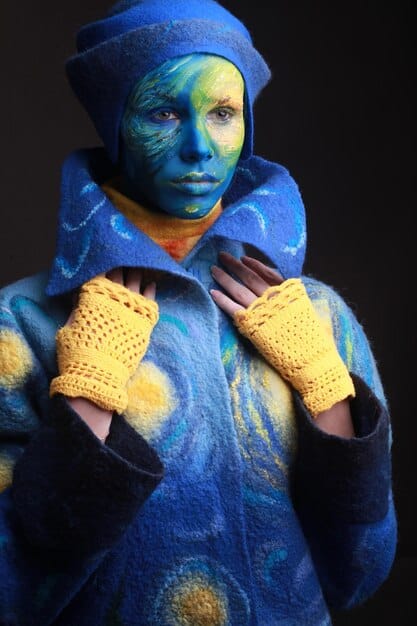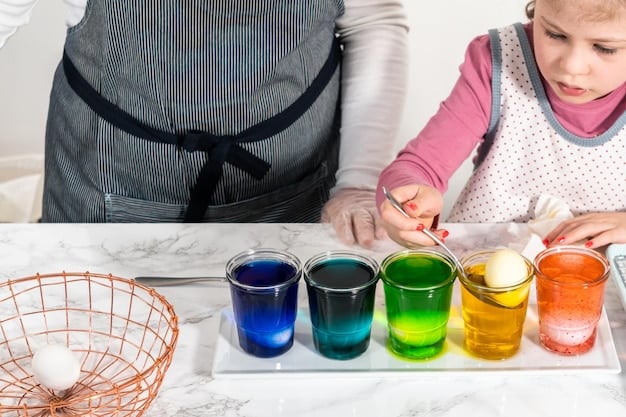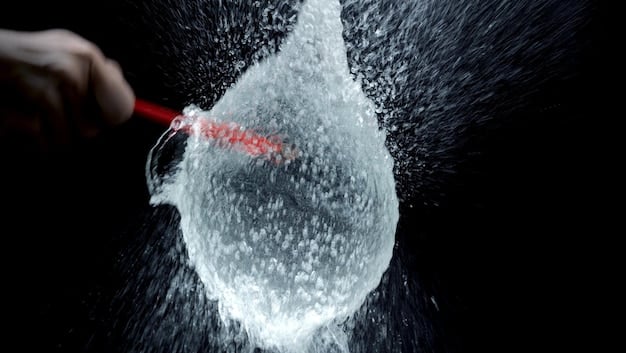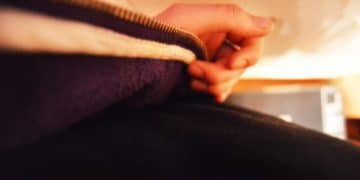Cosplay Fabric Dyeing Guide: Custom Colors for Your Costume

Cosplay Fabric Dyeing Guide offers a comprehensive overview of techniques and best practices for achieving custom colors on various fabrics, ensuring your costume is vibrant, unique, and true to your character’s vision.
Creating the perfect cosplay often means getting the colors just right. This Cosplay Fabric Dyeing Guide: Achieving Custom Colors for Your Costume will walk you through everything you need to know to transform ordinary fabric into the extraordinary material your dream costume deserves.
Your Ultimate Cosplay Fabric Dyeing Guide
Embarking on a cosplay journey often involves meticulous planning and attention to detail, particularly when it comes to color. Achieving the perfect shade for your costume fabric is crucial for an authentic and visually stunning result. This guide dives into the world of fabric dyeing, offering practical tips and techniques to help you create custom colors that bring your cosplay vision to life.
From understanding various dye types to mastering color mixing and application methods, we’ll equip you with the knowledge to tackle any fabric dyeing project. Whether you’re a seasoned cosplayer or just starting out, this comprehensive guide will empower you to transform ordinary fabric into extraordinary pieces that truly capture the essence of your character.
Understanding Different Dye Types
Choosing the right dye is the first step in achieving your desired color. Different fabrics respond best to different types of dyes. Here’s a quick overview:
- Acid Dyes: Ideal for protein-based fibers like wool, silk, and nylon, known for their vibrant colors and excellent colorfastness.
- Fiber Reactive Dyes: Perfect for cellulose fibers such as cotton, linen, and rayon, offering good washability and a wide range of colors.
- All-Purpose Dyes: A blend of different dyes meant to work on a variety of fabrics, but may not provide the same level of vibrancy or colorfastness as specialized dyes.
- Disperse Dyes: Specifically designed for synthetic fibers like polyester, acetate, and acrylic, requiring a high-temperature dyeing process.
Essential Tools and Materials for Fabric Dyeing
Before you start, gather all the necessary tools and materials to ensure a smooth and successful dyeing process:
- Fabric: Pre-washed and ready to absorb the dye.
- Dye: Select the appropriate dye type for your fabric.
- Dye Fixative: Helps to set the dye and improve colorfastness.
- Containers: Large pots or tubs for dyeing and rinsing.
- Stirring Utensils: Spoons or sticks for even dye distribution.
- Gloves and Apron: Protection against dye stains.
- Measuring Tools: Scales and measuring cups for accurate dye ratios.
- Heat Source: Stove or hot plate for heating the dye bath (if required).
By understanding the different dye types and gathering the essential tools, you’ll be well-prepared to create custom colors that perfectly match your cosplay needs. The next step involves mastering the art of color mixing and application techniques to achieve professional-looking results.
In conclusion, selecting the correct dye and preparing your workspace are crucial initial steps. Understanding the properties of each dye type and having the necessary tools at hand will set the stage for a successful and vibrant cosplay fabric dyeing experience.
Mastering Color Mixing for Cosplay Fabrics
Creating custom colors often requires blending different dyes together. Knowing basic color theory and mixing techniques is essential. Let’s explore how to mix dyes effectively to achieve your desired hues for your cosplay fabric.
Understanding the color wheel and how primary, secondary, and tertiary colors interact will give you the foundation to create unique blends. Moreover, precise measuring and careful adjustments are vital in replicating consistent results.

Understanding the Color Wheel
The color wheel is your best friend when it comes to mixing dyes. Here’s a quick breakdown:
- Primary Colors: Red, yellow, and blue – these cannot be created by mixing other colors.
- Secondary Colors: Green, orange, and purple – created by mixing two primary colors.
- Tertiary Colors: Colors created by mixing a primary color with a neighboring secondary color (e.g., red-orange).
Tips for Accurate Color Mixing
Achieving consistent results requires precision. Here are some helpful tips:
- Measure Accurately: Use measuring spoons or scales to ensure precise dye ratios.
- Keep Records: Note down the exact amounts of each dye used in your blends.
- Test Swatches: Always test your dye mixture on a small fabric swatch before dyeing the entire piece.
- Adjust Gradually: Add small amounts of dye to adjust the color as needed.
By mastering color mixing techniques and understanding the color wheel, you can create an almost limitless range of custom colors for your cosplay fabric. Keep meticulous records of your blends, test frequently, and gradually adjust to achieve the perfect shade. Practice and experimentation will refine your technique over time.
In essence, successful color mixing hinges on understanding color relationships and precise execution. Learning how to manipulate the color wheel and carefully adjust your mixtures will allow you to create truly unique and vibrant hues for your cosplay projects, enhancing their overall impact and authenticity.
Preparing Your Fabric for Dyeing
Proper preparation is crucial for achieving even and vibrant results when dyeing fabric for cosplay. Pre-washing, mordanting, and understanding fabric types are key steps to ensure the dye adheres correctly and the color lasts.
This section will guide you through the preparation process, detailing how to clean your fabric, apply mordants if necessary, and select the right approach based on the material you’re working with. By following these steps, you’ll optimize the dye uptake and overall finish of your fabric.
Pre-Washing the Fabric
Always pre-wash your fabric before dyeing to remove any sizing, oils, or dirt that can interfere with dye absorption. Use a mild detergent and warm water. This ensures the dye can penetrate the fibers evenly.
Mordanting for Better Dye Uptake
Mordanting is a process that helps the dye bind to the fabric more effectively. This is especially important for natural fibers. Common mordants include:
- Alum: Suitable for most fabrics, it brightens colors and helps the dye adhere well.
- Iron: Enhances darker colors but can weaken the fabric if used excessively.
- Tannin: Used as a pre-mordant for cotton, especially when using natural dyes.
The technique of mordanting is pivotal for achieving long-lasting and vibrant colors, particularly on natural fibers. Choosing the correct mordant and applying it properly maximizes dye absorption, leading to more professional and durable results. This step can significantly elevate the quality of your dyed fabric.
In summary, preparing your fabric with pre-washing and appropriate mordanting techniques is vital for achieving optimal dyeing results. These steps ensure the fabric is clean, receptive, and able to form a strong bond with the dye, leading to vibrant, even, and long-lasting colors for your cosplay projects.

Dyeing Techniques for Cosplay Fabrics
Once your fabric is prepared, it’s time to dive into the dyeing process. Different techniques yield different results, so choosing the right method is crucial. Here’s an overview of common dyeing techniques suitable for cosplay fabrics.
Whether you prefer immersion dyeing for uniform colors, tie-dye for unique patterns, or hand-painting for intricate designs, understanding the nuances of each technique will help you achieve the desired outcome. This section offers practical guidance on how to execute these methods effectively.
Immersion Dyeing
Immersion dyeing involves submerging the fabric in a dye bath for a specific period. This technique is ideal for achieving a uniform color throughout the fabric.
Steps:
- Fill a large pot with hot water and add the dye according to package instructions.
- Stir the dye bath thoroughly to ensure even distribution.
- Submerge the pre-wetted fabric in the dye bath, ensuring it is fully covered.
- Stir the fabric regularly for the recommended time (usually 30-60 minutes).
- Remove the fabric and rinse it under cold water until the water runs clear.
Tie-Dye
Tie-dye is a resist dyeing technique that creates patterns by folding, twisting, and tying the fabric before dyeing. This method is perfect for adding unique and colorful designs to your cosplay fabrics.
Hand-Painting Fabric
Hand-painting allows for intricate designs and custom artwork on your fabrics. This technique involves applying dye directly to the fabric using brushes or sponges.
In conclusion, choosing the right dyeing technique depends on the desired result for your cosplay fabric. Immersion dyeing provides uniform color, tie-dye adds unique patterns, and hand-painting allows for intricate designs. Each technique offers creative possibilities to enhance the visual appeal of your costumes.
Troubleshooting Common Dyeing Issues
Even with careful preparation, dyeing can sometimes present challenges. Identifying and addressing common issues promptly can save your project. Here are some troubleshooting tips for common dyeing problems.
Understanding the causes of uneven dyeing, color bleeding, and fading will allow you to take corrective action. This section offers practical solutions to ensure your fabric dyeing projects remain on track and achieve the desired results.
Uneven Dyeing
Uneven dyeing can result from inadequate dye distribution or insufficient fabric preparation. Solutions include:
- Stirring Regularly: Ensure the fabric is stirred continuously during immersion dyeing.
- Proper Pre-Washing: Remove any sizing or oils that may resist dye absorption.
- Using a Leveling Agent: Add a leveling agent to the dye bath to promote even dye uptake.
Color Bleeding
Color bleeding occurs when excess dye is not properly rinsed out of the fabric. To prevent this:
Fading Colors
Fading can result from using low-quality dyes or improper dye fixation. To prevent fading:
- Use High-Quality Dyes: Invest in reputable dye brands.
- Use a Dye Fixative: Follow the manufacturer’s instructions for proper fixation.
- Avoid Direct Sunlight: Store dyed fabrics away from direct sunlight to prevent fading.
By understanding the causes of common dyeing issues and applying the appropriate troubleshooting techniques, you can minimize problems and achieve vibrant, long-lasting colors on your cosplay fabrics. Consistent preparation and attention to detail are key to successful dyeing projects.
In summary, troubleshooting dyeing problems requires understanding their causes and applying targeted solutions. Whether it’s uneven coloration, color bleeding, or premature fading, addressing these issues promptly ensures the integrity and vibrancy of your dyed fabrics. With diligence and the right corrective actions, you can achieve professional-quality results for your cosplay projects.
Maintaining Your Dyed Cosplay Fabrics
Once your cosplay fabrics are dyed, proper care and maintenance will ensure they stay vibrant and beautiful for years to come. Understanding how to wash, dry, and store your dyed fabrics is essential for preserving their colors and integrity.
This section provides practical tips on how to prolong the life of your dyed fabrics, including gentle washing techniques, appropriate drying methods, and storage solutions. By following these guidelines, you’ll keep your cosplay costumes looking their best.
Washing Dyed Fabrics
When washing dyed fabrics, follow these guidelines to prevent color loss and damage:
- Wash Separately: Always wash dyed fabrics separately, especially for the first few washes.
- Use Cold Water: Cold water helps prevent dye from bleeding.
- Mild Detergent: Use a gentle, pH-neutral detergent.
- Avoid Harsh Chemicals: Do not use bleach or fabric softeners, as they can damage the dye.
Drying Dyed Fabrics
The way you dry your dyed fabrics can also impact their longevity. Consider these tips:
- Air Dry: Air drying is the gentlest method. Hang the fabric in a shaded area to prevent fading.
- Avoid Direct Sunlight: Direct sunlight can cause the dye to fade.
- Low Heat Tumble Dry: If you must use a dryer, use the lowest heat setting.
Storing Your Dyed Fabrics
Proper storage is crucial for maintaining the colors and condition of your dyed cosplay fabrics. Consider these strategies:
- Store in a Dark Place: Keep fabrics away from direct sunlight and UV light.
- Use Acid-Free Paper: When storing delicate items, wrap them in acid-free tissue paper to prevent discoloration.
- Avoid Dampness: Store fabrics in a dry, well-ventilated area to prevent mildew and mold.
By following these tips on washing, drying, and storing your dyed fabrics, you can significantly extend their lifespan and keep your cosplay costumes looking vibrant and new. Consistent care and attention will ensure your creations remain stunning for years to come.
In essence, maintaining dyed cosplay fabrics involves gentle care and protective storage practices. By washing items separately in cold water with mild detergents, avoiding harsh chemicals and direct sunlight, and storing fabrics in dark, dry places, you can preserve their vivid colors and structural integrity, ensuring your costumes look exceptional for every event.
| Key Point | Brief Description |
|---|---|
| 🎨 Dye Selection | Choose the right dye type for your fabric material for optimal results. |
| 🧪 Fabric Prep | Pre-wash to remove sizing; mordant natural fibers for better dye uptake. |
| 🌈 Color Mixing | Use color wheel principles; measure precisely and test swatches. |
| 💧 Washing | Wash separately in cold water; use mild detergent without harsh chemicals. |
Frequently Asked Questions (FAQ)
▼
For cotton fabrics, fiber reactive dyes are the best choice. They bond well with cellulose fibres, providing excellent washability and a wide range of vibrant colors ideal for custom cosplay designs.
▼
To prevent color bleeding, always wash dyed fabrics separately in cold water. Using a mild detergent without harsh chemicals and adding a dye fixative to the wash can also help.
▼
Mordanting is a process that helps dye bind to fabric fibres. It’s particularly important for natural fibres like cotton and linen, enhancing color vibrancy and improving the dye’s longevity and resistance to washing.
▼
While all-purpose dyes can be used on various fabrics, they don’t always provide the same level of vibrancy or colorfastness as specialized dyes. It’s best to use dyes specifically formulated for your fabric type.
▼
Store dyed cosplay fabrics in a dark, dry place away from direct sunlight. Wrapping delicate items in acid-free paper can also help prevent discoloration and maintain the colors over time.
Conclusion
By mastering the techniques and best practices outlined in this guide, you’ll be well-equipped to create custom colors that perfectly match your cosplay vision. From selecting the right dyes to maintaining the vibrancy of your fabrics, each step will help you bring your characters to life with stunning accuracy and detail.





